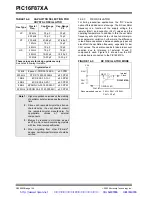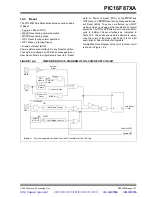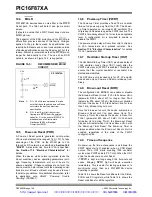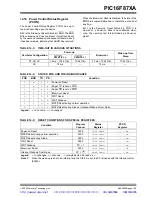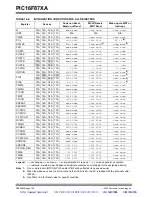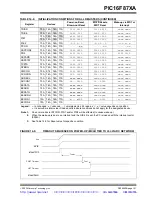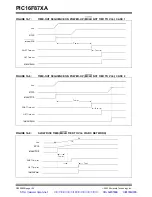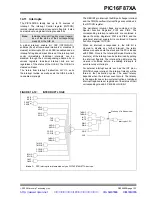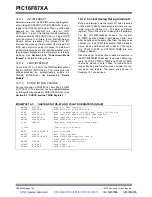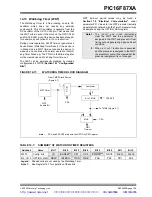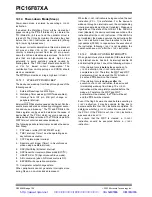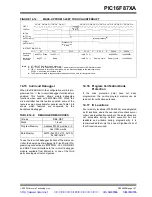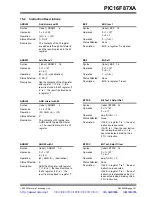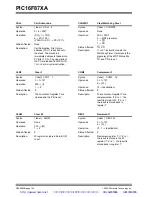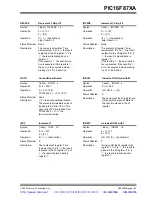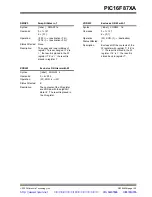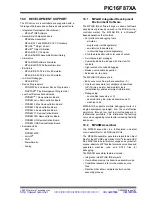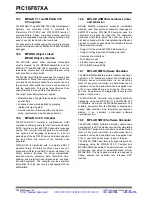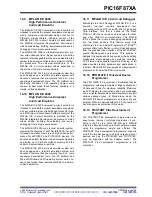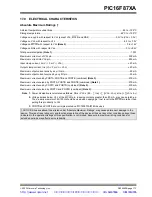
2003 Microchip Technology Inc.
DS39582B-page 159
PIC16F87XA
15.0
INSTRUCTION SET SUMMARY
The PIC16 instruction set is highly orthogonal and is
comprised of three basic categories:
• Byte-oriented operations
• Bit-oriented operations
• Literal and control operations
Each PIC16 instruction is a 14-bit word divided into an
opcode which specifies the instruction type and one or
more operands which further specify the operation of
the instruction. The formats for each of the categories
is presented in Figure 15-1, while the various opcode
fields are summarized in Table 15-1.
Table 15-2 lists the instructions recognized by the
MPASM™ Assembler. A complete description of each
instruction is also available in the PICmicro
®
Mid-Range
MCU Family Reference Manual (DS33023).
For byte-oriented instructions, ‘f’ represents a file
register designator and ‘d’ represents a destination
designator. The file register designator specifies which
file register is to be used by the instruction.
The destination designator specifies where the result of
the operation is to be placed. If ‘d’ is zero, the result is
placed in the W register. If ‘d’ is one, the result is placed
in the file register specified in the instruction.
For bit-oriented instructions, ‘b’ represents a bit field
designator which selects the bit affected by the opera-
tion, while ‘f’ represents the address of the file in which
the bit is located.
For literal and control operations, ‘k’ represents an
eight or eleven-bit constant or literal value
One instruction cycle consists of four oscillator periods;
for an oscillator frequency of 4 MHz, this gives a normal
instruction execution time of 1
µ
s. All instructions are
executed within a single instruction cycle, unless a
conditional test is true, or the program counter is
changed as a result of an instruction. When this occurs,
the execution takes two instruction cycles with the
second cycle executed as a
NOP
.
All instruction examples use the format ‘
0xhh
’ to
represent a hexadecimal number, where ‘
h
’ signifies a
hexadecimal digit.
15.1
READ-MODIFY-WRITE
OPERATIONS
Any instruction that specifies a file register as part of
the instruction performs a Read-Modify-Write (R-M-W)
operation. The register is read, the data is modified,
and the result is stored according to either the instruc-
tion or the destination designator ‘d’. A read operation
is performed on a register even if the instruction writes
to that register.
For example, a “
CLRF PORTB
” instruction will read
PORTB, clear all the data bits, then write the result
back to PORTB. This example would have the unin-
tended result that the condition that sets the RBIF flag
would be cleared.
TABLE 15-1:
OPCODE FIELD
DESCRIPTIONS
FIGURE 15-1:
GENERAL FORMAT FOR
INSTRUCTIONS
Note:
To maintain upward compatibility with
future PIC16F87XA products, do not use
the
OPTION
and
TRIS
instructions.
Field
Description
f
Register file address (0x00 to 0x7F)
W
Working register (accumulator)
b
Bit address within an 8-bit file register
k
Literal field, constant data or label
x
Don't care location (=
0
or
1
).
The assembler will generate code with x =
0
.
It is the recommended form of use for
compatibility with all Microchip software tools.
d
Destination select; d =
0
: store result in W,
d =
1
: store result in file register f.
Default is d =
1.
PC
Program Counter
TO
Time-out bit
PD
Power-down bit
Byte-oriented file register operations
13 8 7 6 0
d =
0
for destination W
OPCODE d f (FILE #)
d =
1
for destination f
f = 7-bit file register address
Bit-oriented file register operations
13 10 9 7 6 0
OPCODE b (BIT #) f (FILE #)
b = 3-bit bit address
f = 7-bit file register address
Literal and control operations
13 8 7 0
OPCODE k (literal)
k = 8-bit immediate value
13 11 10 0
OPCODE k (literal)
k = 11-bit immediate value
General
CALL
and
GOTO
instructions only
http://www.xinpian.net
提供单片机解密、IC解密、芯片解密业务
010-62245566 13810019655


